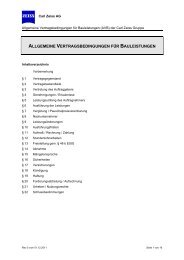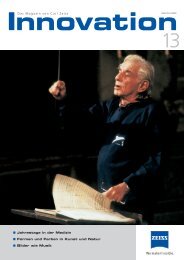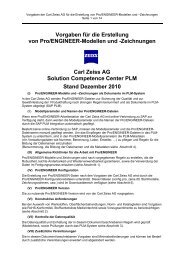Download PDF - Carl Zeiss
Download PDF - Carl Zeiss
Download PDF - Carl Zeiss
You also want an ePaper? Increase the reach of your titles
YUMPU automatically turns print PDFs into web optimized ePapers that Google loves.
ful Magnification<br />
(4)<br />
n BR · sin �’= d<br />
2b<br />
(In general, the image space is filled<br />
with air, i.e. n BR = 1.0)<br />
When the sine condition is taken into<br />
account,<br />
(5)<br />
n OR · sin � = 2∆y’ = const.<br />
n BR · sin �’ 2∆y<br />
the smallest, still resolvable distance<br />
between two object points, i.e. the<br />
resolution limit 2∆y min , is<br />
2∆ymin = 2∆y’ nBR · sin �’<br />
nOR · sin �<br />
2∆y min =<br />
(6)<br />
2∆y min =<br />
1.22 · b · � · d<br />
2 · b · d · n OR · sin �<br />
0.61 · �<br />
n OR · sin �<br />
The reciprocal value of (6) is described<br />
as resolving power, which<br />
should have as high a value as possible.<br />
The benefits<br />
of immersion<br />
The fundamental resolution formula<br />
(6) valid for objects which are not<br />
self-luminous states that the resolution<br />
limit depends on two factors,<br />
namely the wavelength � and the numerical<br />
aperture of the objective. If,<br />
therefore, the resolving power is to<br />
be increased or the resolution limit<br />
minimized accordingly, shorter wavelengths<br />
and a larger numerical aperture<br />
must be selected.<br />
Innovation 15, <strong>Carl</strong> <strong>Zeiss</strong> AG, 2005<br />
What should be done, however, if<br />
a very specific wavelength or white<br />
light must be used and if, with n OR =<br />
1.0, the maximum value of 0.95, for<br />
example, has already been allocated<br />
to the dry aperture? In such cases,<br />
immersion objectives are used, i. e.<br />
objectives whose front lens immerses<br />
(immergere [Lat.]) into a liquid, the<br />
optical data of which has been included<br />
in the objective’s computation.<br />
In the special case of homogeneous<br />
immersion, the refractive indices<br />
of the immersion liquid n 2 and<br />
the front lens n 3 have been matched<br />
for the centroid wavelength 2) in such<br />
a way that the rays emitted by an object<br />
point OP (Fig. 5) pass the immersion<br />
film without being refracted and<br />
can thus be absorbed by the front<br />
lens of the objective. In this case, the<br />
numerical aperture has been increased<br />
by the factor n 2 , i. e. the<br />
wavelength and therefore the resolution<br />
limit has decreased to 1/n 2 . This<br />
means that the numerical aperture of<br />
a dry objective and an immersion objective<br />
differs by the factor n 2 , provided<br />
the objectives can absorb rays<br />
of the same angular aperture. The<br />
standard numerical apertures of immersion<br />
objectives are 1.25 (water<br />
immersion), 1.30 glycerin immersion)<br />
and 1.40 (oil or homogeneous immersion).<br />
The values correspond to<br />
half the angular apertures � = 56°,<br />
59° and 68°; for dry objectives, the<br />
numerical apertures would be reduced<br />
to 0.83, 0.86 and 0.93.<br />
Another advantage of immersion<br />
objectives over dry objectives is their<br />
considerable reduction or even entire<br />
elimination of interfering reflected<br />
light produced at the front surfaces<br />
of the coverslip and the front lens of<br />
the objective.<br />
For the sake of completeness, we<br />
would also like to mention the immersion<br />
technique used to determine<br />
the refractive index of isolated solid<br />
bodies. The object to be measured is<br />
2��<br />
n 2 = 1.0 (air)<br />
1<br />
2<br />
2� 2�’<br />
Lens diameter d<br />
2�<br />
a b<br />
OP<br />
2�<br />
2�’<br />
Dry objective Immersion objective<br />
2��’<br />
4<br />
Objective front lens<br />
(e. g. BK 7,<br />
n3 = 1.518)<br />
Homogeneous<br />
immersion,<br />
n2 = 1.518 (oil)<br />
Coverslip,<br />
n1 = 1.518<br />
Object(point) of<br />
refractive index nO Fig. 4:<br />
The resolving power of the<br />
microscope (according to<br />
R.W. Pohl, 1941)<br />
2∆y object, 2∆y’ image,<br />
2� angular aperture<br />
on the object side,<br />
2�’ angular aperture<br />
on the image side,<br />
2� resolvable angle size<br />
on the object side,<br />
2�’ resolvable angle size<br />
on the image side.<br />
Fig. 5:<br />
Influence of the immersion<br />
medium on the numerical<br />
aperture of the objective.<br />
2� = Angular aperture<br />
of the objective<br />
(numerical aperture<br />
= n 2 • y sin �)<br />
1 = Limit angle of<br />
total reflection<br />
(= arcsin [n 2 /n 1 ]<br />
� 41°) reached;<br />
grazing light exit.<br />
2 = Total reflection<br />
5<br />
13
















